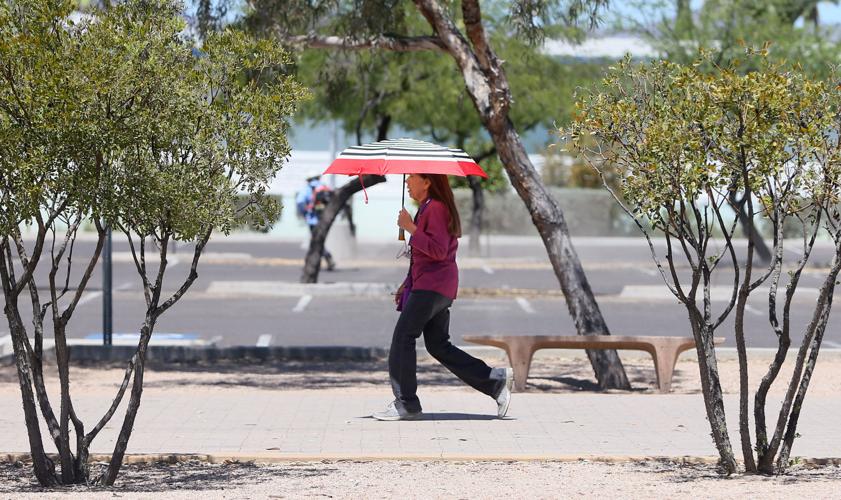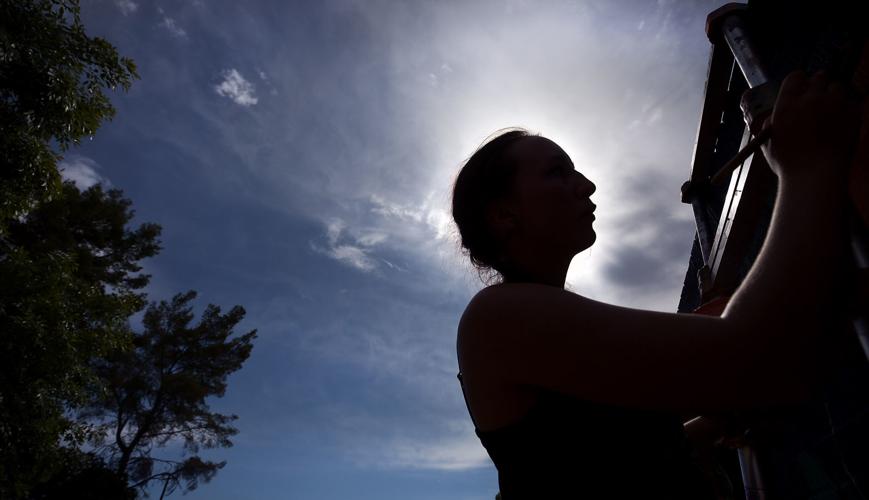Tucson should get its first 2020 burst of sustained warmer weather this week, with temperatures forecast to hit the mid-80s from Tuesday through next weekend.
Many if not most viruses are known to be seasonal, flourishing in wintertime, dissipating in summer and returning in fall.
So does that mean that we soon could be safe from coronavirus (SARS-CoV-2 — the virus’s formal name)?
Maybe, but don’t bet the farm on it, many experts say. And even if summer heat drives the virus away, most experts predict it will bite back in the fall.
Several studies have come out in the past week or so linking this year’s spread of CoV-2 to temperature. They found most of the cities and countries with the most cases had cool to cold weather when their caseloads peaked or started growing fast.
The behavior shown by this virus in these studies is consistent with that of four less deadly forms of coronavirus that have also been shown to be seasonal in nature, the studies’ authors said.
Last week, Dr. Anthony Fauci of the National Institutes of Health, the federal government’s leading scientific expert on the coronavirus, himself said this virus is likely to be seasonal, emphasizing he expects it to return in the fall.
But the new studies aren’t yet peer-reviewed, let alone published. Some have come under fire from epidemiologists and other scientists who say they don’t take into account other possible factors.
“We’re all hopeful. But the jury’s still out,” said Bob England, the Pima County Health Department’s interim director. “There is some data to suggest it might be somewhat seasonal, because of the particular latitude of places where the outbreak took off and the order in which they took off. That would be really helpful. But brand-new pathogens do not behave seasonally the first time out.”
“I would love to give some hope. Unfortunately I cannot at this time,” said Jessica Rigler, deputy director of the Arizona Department of Health Services. “We don’t know enough about this virus. It’s so new — since it was identified in December, there’s been no opportunity to do extensive research on it.”
For the latest coronavirus, there’s reason to expect that like others, it may transmit somewhat more efficiently in winter than in summer, though scientists don’t know the mechanisms responsible, wrote professor Marc Lipsitch, a Harvard University epidemiologist, in a recent blog post seeking to debunk the “myth” that warmer weather will make a big difference. “The size of the change is expected to be modest, and not enough to stop transmission on its own.”
“Based on the analogy of pandemic flu, we expect that SARS-CoV-2, as a virus new to humans, will face less immunity and thus transmit more readily even outside of the winter season. Changing seasons and school vacation may help, but are unlikely to stop transmission,” Lipsitch wrote.
These new studies are indeed promising, “but the telltale is that the titles hedge: ‘Warm, humid weather could slow;’ ‘Warmer weather may slow, but not halt’ the virus,” said University of Arizona professor Felicia Goodrum, a virologist.
If the virus does give us a summertime reprieve, the time between now and November “will be borrowed time to ramp up the testing capability, the hospital beds, the equipment needed to protect health workers, and the availability of ventilators,” Goodrum said. “It will be a reason not to party, but to buckle down and get prepared the way I wish we would have been all along.”
Why viruses hibernate in warm weather
That viruses are seasonal in nature has been known for thousands of years, researchers from Yale and Zurich universities wrote in a paper published this month, as the latest coronavirus was exploding across the United States.
Accounts of respiratory infectious diseases starting in winter date at least to around 400 B.C., in Hippocrates’ book on epidemics.
The two major contributing factors dictating the spread of viruses are environmental changes and human behavior, the Yale and Zurich study said.
One reason viruses are thought to spread more effectively in winter is that respiratory droplets — believed to be a key factor spreading this virus — remain airborne for longer in colder weather.
Another potential factor: Viruses degrade more quickly on hotter surfaces, possibly because a protective layer of fat that envelops them dries out quicker, Goodrum said.
The condition of the host organism in the body also is a factor, she said. During the winter, dry forced air, used in many heater devices, can dry out the body’s protective mucosal layers and cilia functions in the nose, Goodrum said. Both the mucosal lining and the cilia — small hairs inside the nose — remove particulates from the nose before they get into the lungs.
If dry air from a heater compromises those protections, that can increase susceptibility to infection, she said.
Human behavior is also a huge factor.
With colds, for instance, people get them in the summer but not as often, in part because people spend more time outdoors, with winds blowing, doing their own form of “social distancing,” said professor Kristie Ebi, an epidemiologist at the University of Washington in another coronavirus hot spot, Seattle. “You don’t get people packed into places where the air circulation is not as good.”
Partly because people haven’t yet developed an immunity to the latest coronavirus, “we don’t know if seasonality is effective in the initial wave of a pandemic,” Ebi said.
“In this case, because nobody has immunity, everyone I interact with could come down with the disease if I’m transmitting it.”
What studies are finding
One of the new studies, done by Massachusetts Institute of Technology scientists, found that as of March 22, 90% of all known transmissions of the current coronavirus on a global scale occurred at temperatures ranging from 37 to 62 degrees and that only 6% of cases occurred in regions with average winter temperatures of more than 64 degrees.
Within the U.S., northern states with cooler climates have had much higher growth rates in the virus, the study said. While Louisiana’s rapid increase in the virus of late is a major exception to this trend, the huge swarm of out-of-state and out-of-country visitors to New Orleans’ Mardi Gras in February has been blamed for much of that increase.
A second study, from University of Maryland scientists, found similar patterns, in which the spread of the virus was heavily concentrated in areas of low humidity and with average temperatures ranging from 41 to nearly 52 degrees.
Both studies had cautionary notes, however. The Maryland study, for instance, said that during the 2009 H1N1 influenza pandemic, and in early whooping cough pandemics in Persia and France during the 1400s and 1500s, these epidemics had peaks in periods well outside expected seasonal patterns.
“Respiratory viruses can be transmitted in any season, in any location in the world, including the subtropics and tropics,” cautioned virologist, medical doctor and associate professor Mohammad Sajadi, a co-author of the Maryland study, in an email to the Arizona Daily Star.
A third new study offers a much bleaker outlook, noting that some tropical and other warmer countries are starting to see evidence of the virus spreading there. While many of those, including Malaysia and the Philippines, get lots of travelers from China, where the virus began, this trend is also happening in some warm, non-Asian countries, including Burkina Faso, the Congo, Panama and Paraguay, said the study by the Centre for Mathematical Modeling of Infectious Diseases.
“While warmer weather may slightly reduce transmission of SARS-CoV-2, there is no evidence to suggest that warmer conditions in Northern Hemisphere summer months will reduce the effectiveness of SARS-CoV-2 transmission to an extent that few additional interventions are needed to curb its spread,” that report said. Another critic of the warmer-is-better theory is University of Arizona professor Michael Worobey, an epidemiologist who has studied the 1918 Spanish flu extensively. He blasted the MIT study on the new coronavirus as “almost worse than useless.”
“There are so many factors impacting the case counts of this virus,” he said. “The main issue is that places like North America and Western Europe where there is a lot of capacity to test for the virus happen to be kind of cooler places than lots of other countries. We just don’t have a complete picture of the prevalence of the virus, because there’s a lack of testing in so many places including Arizona.”
Worobey added he’s concerned that such studies “could lead people to have a false sense of security that somehow the weather here is going to save us. There is no reason to think that’s the case.”
On a micro level, a UCLA researcher noted that a glaring contrast exists between cold New York City and milder Los Angeles’ coronavirus emergencies, even though both their caseloads have skyrocketed this month.
Los Angeles, whose high temperatures have exceeded New York’s by up to 20 degrees in winter and spring, had 1,230 patients Thursday compared to 23,000 in New York, observed professor Zuo-Feng Zhang of UCLA’s Fielding School of Public Health.
At the same time, New York’s high population densities compared to Los Angeles and most everywhere else in the U.S. are clearly a huge factor there, showing that temperature doesn’t act alone, Zhang said.
“My sense is that I think it’s probably going to drop down in May or June,” not only due to temperature but due to shutdowns of stores, entertainment venues and schools, Zhang said.
But if Tucson gets a reprieve from the virus when the temperatures hit the 90s and 100s, people might not see the need for protective measures, he added — and Arizona could still import the disease from cooler states.
“If those patients get into your state, and they contact other people, that can cause outbreaks,” he said.





